Is Mercury NZ Limited (NZSE:MCY) Creating Value For Shareholders?

Today we'll evaluate Mercury NZ Limited (NZSE:MCY) to determine whether it could have potential as an investment idea. Specifically, we're going to calculate its Return On Capital Employed (ROCE), in the hopes of getting some insight into the business.
First up, we'll look at what ROCE is and how we calculate it. Next, we'll compare it to others in its industry. Finally, we'll look at how its current liabilities affect its ROCE.
Understanding Return On Capital Employed (ROCE)
ROCE is a metric for evaluating how much pre-tax income (in percentage terms) a company earns on the capital invested in its business. In general, businesses with a higher ROCE are usually better quality. Overall, it is a valuable metric that has its flaws. Author Edwin Whiting says to be careful when comparing the ROCE of different businesses, since 'No two businesses are exactly alike.
How Do You Calculate Return On Capital Employed?
Analysts use this formula to calculate return on capital employed:
Return on Capital Employed = Earnings Before Interest and Tax (EBIT) ÷ (Total Assets - Current Liabilities)
Or for Mercury NZ:
0.053 = NZ$301m ÷ (NZ$6.5b - NZ$821m) (Based on the trailing twelve months to June 2019.)
Therefore, Mercury NZ has an ROCE of 5.3%.
Check out our latest analysis for Mercury NZ
Does Mercury NZ Have A Good ROCE?
ROCE can be useful when making comparisons, such as between similar companies. It appears that Mercury NZ's ROCE is fairly close to the Electric Utilities industry average of 6.3%. Independently of how Mercury NZ compares to its industry, its ROCE in absolute terms is low; especially compared to the ~2.4% available in government bonds. It is likely that there are more attractive prospects out there.
You can see in the image below how Mercury NZ's ROCE compares to its industry. Click to see more on past growth.
When considering ROCE, bear in mind that it reflects the past and does not necessarily predict the future. ROCE can be deceptive for cyclical businesses, as returns can look incredible in boom times, and terribly low in downturns. This is because ROCE only looks at one year, instead of considering returns across a whole cycle. What happens in the future is pretty important for investors, so we have prepared a free report on analyst forecasts for Mercury NZ.
What Are Current Liabilities, And How Do They Affect Mercury NZ's ROCE?
Short term (or current) liabilities, are things like supplier invoices, overdrafts, or tax bills that need to be paid within 12 months. Due to the way the ROCE equation works, having large bills due in the near term can make it look as though a company has less capital employed, and thus a higher ROCE than usual. To counter this, investors can check if a company has high current liabilities relative to total assets.
Mercury NZ has total liabilities of NZ$821m and total assets of NZ$6.5b. As a result, its current liabilities are equal to approximately 13% of its total assets. With a very reasonable level of current liabilities, so the impact on ROCE is fairly minimal.
What We Can Learn From Mercury NZ's ROCE
While that is good to see, Mercury NZ has a low ROCE and does not look attractive in this analysis. But note: make sure you look for a great company, not just the first idea you come across. So take a peek at this free list of interesting companies with strong recent earnings growth (and a P/E ratio below 20).
For those who like to find winning investments this free list of growing companies with recent insider purchasing, could be just the ticket.
We aim to bring you long-term focused research analysis driven by fundamental data. Note that our analysis may not factor in the latest price-sensitive company announcements or qualitative material.
If you spot an error that warrants correction, please contact the editor at editorial-team@simplywallst.com. This article by Simply Wall St is general in nature. It does not constitute a recommendation to buy or sell any stock, and does not take account of your objectives, or your financial situation. Simply Wall St has no position in the stocks mentioned. Thank you for reading.

 Yahoo Finance
Yahoo Finance 
